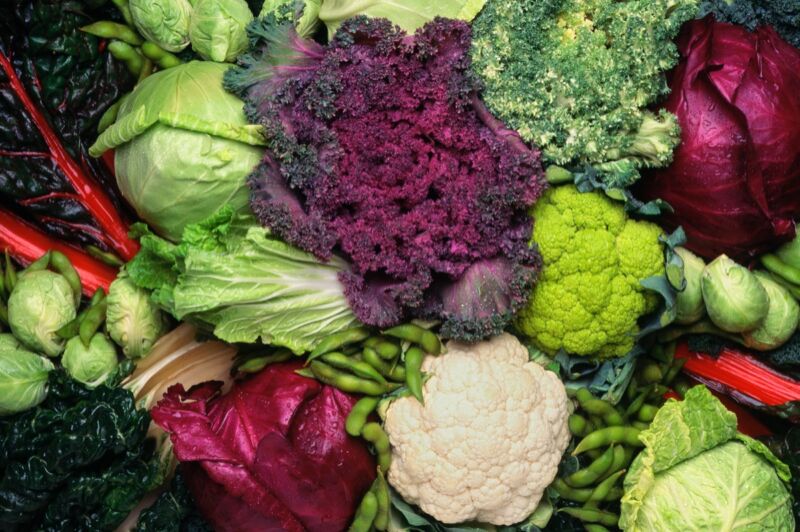For many people, nothing is less tantalizing than a big plate of steamed cruciferous vegetables at dinner. Yes, it's supposed to be good for us, but that bitter taste is just too overpowering and unpleasant. This is especially true for young children, as any frustrated parent can attest. But an aversion to broccoli, cauliflower, and similar foods is not just people being finicky; some genetics are at play. And according to a recent paper in the Journal of Agricultural and Food Chemistry, a person's oral microbiome may also be an important factor.
In 1931, a chemist named Arthur L. Fox accidentally released the powdered form of phenylthiocarbamide (PTC) in his lab. He didn't notice anything unusual, but his lab mate sensed a bitter taste. Subsequent experiments confirmed that this variation existed in the broader population and that not being able to taste bitterness was a recessive genetic trait. For instance, about 25 percent of the population can't taste propylthiouracil (PROP), a chemical that is similar to the bitter compounds found in cabbage, raw broccoli, coffee, tonic water, and dark beers. That population is, like Fox, essentially "taste blind."
There are 25 "bitterness" genes known thus far; different bitter foods act through different receptors, and people can be high or low responders for one but not another. Many scientists think that those who can sense bitterness are probably responding to compounds called glucosinolates, present in most cruciferous vegetables, like broccoli, Brussels sprouts, and cauliflower. Those glucosinolates are responsible for much of the nutritional benefits of those veggies, but they also break down into pungent compounds that can negatively trigger many people's bitter taste receptors. (I happen to dislike all three, as well as raw tomatoes, and I refuse to feel bad about that.)
However, no one gene could ever be responsible for whether we love or hate specific foods. So many different compounds are related to flavor and aroma, not to mention texture (mouth feel), and all of them might contribute to how much we savor or loathe a food. And now we can add our oral microbiomes to the mix. While there is also a genetic component to one's individual microbiome, according to Damian Frank, co-author of this latest study, that makeup can change over the course of one's life. So environment plays a role as well.
This latest study builds on the results of a 2018 study involving raw cabbage, which found significant variability in the production of sulfurous volatile compounds in saliva between individuals. Saliva keeps our mouths moist, fights germs and bad breath, and helps us chew and swallow food. And past studies have provided evidence that saliva plays an important role when it comes to flavor release in foods and hence our perception of enjoyment.
Broccoli and its cruciferous cousins can produce an enzyme called S-methyl-cysteine-sulfoxide (SMCSO) when plant tissues are damaged—a kind of defense mechanism. Past studies have shown that some people's saliva contains high levels of a particular bacteria that can produce these sulfuric enzymes, and this in turn could affect how people experience the flavors of cruciferous vegetables, among other foods. "This molecule has been basically ignored for a long time, because it's just not as exciting," said Frank.

Frank and his colleagues recruited 98 pairs of children (between the ages of 6 and ![]() and parents and had them chew on a bit of wax paper to produce saliva for analysis—a task that proved challenging for many. In the end, 35 pairs of the total 98 were able to produce enough saliva for this phase of the experiment, although all participated in the ranking stages. These samples were then exposed to raw cauliflower powder and analyzed with proton-transfer reaction mass spectrometry to measure individual differences in the production of sulfur volatile compounds in real time.
and parents and had them chew on a bit of wax paper to produce saliva for analysis—a task that proved challenging for many. In the end, 35 pairs of the total 98 were able to produce enough saliva for this phase of the experiment, although all participated in the ranking stages. These samples were then exposed to raw cauliflower powder and analyzed with proton-transfer reaction mass spectrometry to measure individual differences in the production of sulfur volatile compounds in real time.
Next, the team presented all 98 participating parent/child pairs with "sniff pens" containing various pure odor compounds diluted in propylene glycol, and asked them to rate the odors in terms of pleasantness and intensity. Children used an age-appropriate adapted version of the "self-assessment manikin" to graphically record their rankings on a scale of 1 (frowning) to 5 (smiling). Adults used a different 9-point scale. The researchers employed the same scales for the next stage of the study, which involved taste testing samples of both raw and steamed broccoli and cauliflower.
Gas chromatography
Frank et al. also used gas chromatography to identify the primary odor-active volatiles present in both raw and steamed broccoli and cauliflower to see if the cooking process changed those profiles, augmented by a panel of trained experts. Dimethyl trisulfide (DMTS) was the most potent volatile in both raw and steamed vegetables, producing "rotten, sulfurous, and putrid" odors. Not surprisingly, all the participants disliked this volatile—it's also a "potent volatile component of decomposing flesh," per the authors.
Other volatiles added notes of mustard or wood; radish and pungent earth; green, grassy notes; mushroom or fungus; and floral or violet notes, depending on the vegetable. "In general, steaming was associated with a reduction in overall odor intensity in both vegetables, and no evidence of any unique heat-generated odor compounds in either cauliflower of broccoli was found," the authors wrote.
As with the 2018 study, there were large individual differences in the level of sulfur volatile production among the participants. Children whose saliva produced especially high levels of sulfuric volatile compounds disliked the raw broccoli and cauliflower the most. This correlation was not found for the adults in the study, which the authors suggest might explain why some adults eventually learn to tolerate the flavor as they age.
In addition, "There was a significant relationship between children and parents in the amount of sulfur produced, which we're supposing is due to similar oral microbiomes," said Frank. The authors emphasize that, while intriguing, this is a speculative finding, since the team did not analyze which types of bacteria and how many of each type were present in the saliva samples. However, "Other research groups have found significant relationships between the salivary microbiome of parents and children, especially mothers and children," they wrote.
DOI: Journal of Agricultural and Food Chemistry, 2021. 10.1021/acs.jafc.1c03889 (About DOIs).



3175x175(CURRENT).thumb.jpg.b05acc060982b36f5891ba728e6d953c.jpg)

Recommended Comments
There are no comments to display.
Join the conversation
You can post now and register later. If you have an account, sign in now to post with your account.
Note: Your post will require moderator approval before it will be visible.